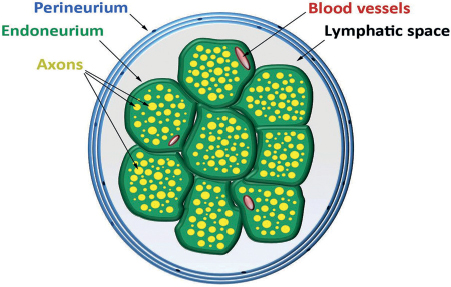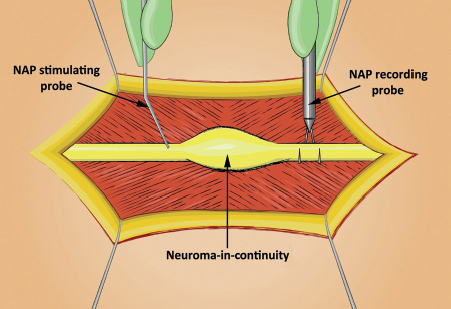65 What are the constituents of a peripheral nerve? Axons, Schwann cells, connective tissue matrix (endoneurium, perineurium, internal and external epineurium) Fig. 65.1 Transverse section of a peripheral nerve consisting of a single nerve bundle. What constitutes the blood–nerve barrier? 1. Endoneurial capillaries containing tight junctions (and devoid of fenestrations) 2. Perineurial tight junctions List four mechanisms of peripheral nerve injury. Compression, laceration, stretch, and ischemia Describe the pathogenesis of chronic nerve compression. Stepwise consequences of blood–nerve barrier breakdown: 1. Edema, ischemia, connective tissue thickening 2. Localized → diffuse demyelination 3. Wallerian degeneration What is wallerian degeneration? Combination of cellular and molecular changes in the distal nerve segment (affecting axons, Schwann cells, myelin, and connective tissue elements) that clears debris and prepares for subsequent axonal regeneration How are nerve injuries classified? According to the anatomical layers of the nerve that have been violated (which, in turn, influences the potential functional outcomes) What is the Seddon classification? Grade 1—neurapraxia: axonal continuity maintained with intact connective tissue elements. Myelin may be disrupted. Associated with local conduction block. Grade 2—axonotmesis: axonal and myelin disruption. Wallerian degeneration followed by regeneration within distal segment along intact endoneurial conduits. Grade 3—neurotmesis: complete nerve transection. No regeneration unless continuity restored. What is the Sunderland classification? Grade 1: Seddon’s neurapraxia Grade 2: Seddon’s axonotmesis Grade 3: axonal and endoneurial disruption (associated with scarring and variable regeneration) Grade 4: axonal, endoneurial, and perineurial disruption (associated with neuroma-in-continuity formation and rare regeneration) Grade 5: Seddon’s neurotmesis What is the Mackinnon classification? Grade 1 to 5: as for Sunderland classification Grade 6: combination of normal findings along with grade 1 to 5 injuries within the same nerve Define neuroma-in-continuity. A collection of disorganized nerve fibers resulting from inadequate apposition of fascicles and unsuccessful axonal sprouting across the injury site Fig. 65.2 Neuroma-in-continuity. If no nerve action potential (NAP) is recorded, neuroma resection with epineural anastomosis is performed. If NAP is recorded, neurolysis with removal of scar tissue if performed.
Basics


![]()
Stay updated, free articles. Join our Telegram channel

Full access? Get Clinical Tree






